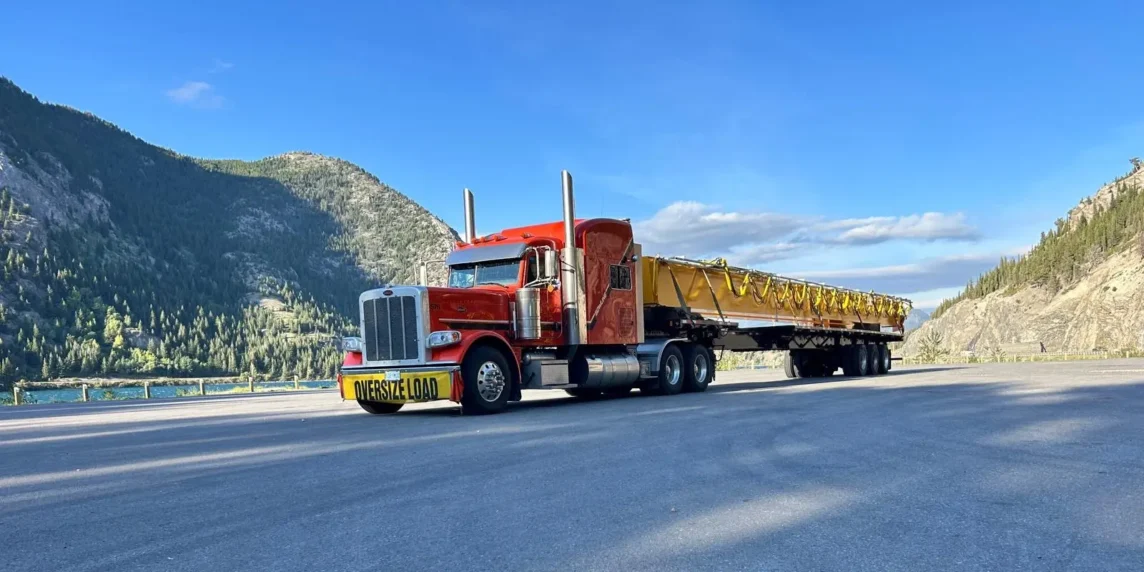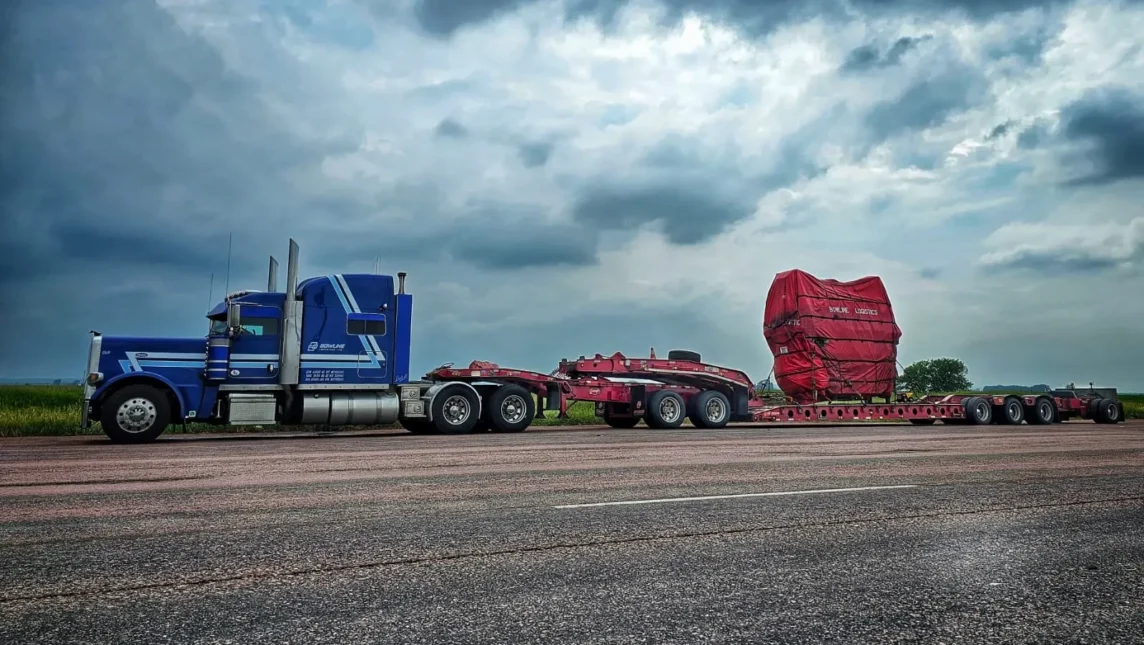Moving freight across the border between Canada and the United States sounds straightforward enough: load a truck, hand over the paperwork, flash a smile at the customs officer, and off you go. Except… not quite.
In reality, cross-border trucking is a finely tuned, regulation-heavy dance between logistics planning, customs clearance, and problem-solving on the fly. And unlike a leisurely summer road trip, this one doesn’t allow for scenic detours, not unless you like fines, shipment delays or having your goods sent back to where they came from.
For shippers and manufacturers, partnering with the right cross-border trucking company can mean the difference between delivering on time and delivering excuses. That’s where Bowline Logistics comes in. But before we get to that, let’s talk about why cross-border freight transport is a whole different beast.
Why Cross-Border Trucking is Not Just “Domestic Plus Paperwork”
Domestic freight transport has its challenges – scheduling, load security, equipment maintenance – but the moment you add an international border, the complexity increases exponentially. Cross-border logistics involves navigating two sets of regulations, customs requirements, and carrier responsibilities.
When your freight is moving from Saskatchewan to South Dakota or from Vancouver to Vegas, your trucking partner needs to:
-
Understand customs clearance procedures for both Canada and the USA.
-
Be equipped for international freight shipping, including USMCA/NAFTA documentation.
-
Manage carrier licensing and insurance in two countries.
In short: cross-border freight solutions demand both experience and precision.
Customs Clearance: The Gatekeeper of Cross-Border Logistics
Ask any veteran in Canada-US freight transport what slows a shipment down, and “customs clearance” will almost always top the list.
The process requires more than a commercial invoice and a handshake. You’ll need:
Bill of Lading (BOL)
The master document of the shipment. Think of the Bill of Lading as the freight world’s version of a boarding pass, ID, and contract all rolled into one. It’s issued by the carrier to the shipper and serves three big purposes:
-
Receipt of Goods: Confirms that the carrier has received the freight in good order.
-
Contract of Carriage: Lays out the agreed terms for transporting the goods from origin to destination.
-
Document of Title: Proves who legally owns the goods while they’re in transit.
For cross-border trucking companies, accuracy here is non-negotiable. Every detail from the shipper’s and consignee’s names to the freight description, weight, and quantity must be spot on. If the BOL says “10 pallets” and customs counts 11, you’re about to have a very long day at the border.
Commercial Invoice
If the Bill of Lading says what’s moving, the Commercial Invoice explains what it’s worth. Customs officers care a lot about that number. This document details:
-
The seller’s and buyer’s full information.
-
A complete description of the goods.
-
Quantities and unit prices.
-
The total value of the shipment.
-
Currency of sale.
-
Incoterms (who’s responsible for freight, insurance, and duties).
Why so much detail? Customs uses the Commercial Invoice to calculate duties and taxes, verify compliance with trade agreements, and make sure you’re not undervaluing goods to sneak in under tariff thresholds. One missing or vague line here can cause your Canada-US freight transport to grind to a halt.
Certificate of Origin
Under the United States–Mexico–Canada Agreement (USMCA), certain goods qualify for reduced or zero tariffs, but only if you can prove where they were made.
This document certifies that the goods meet the agreement’s rules of origin. It needs to be completed accurately and kept on file (often for up to five years) in case customs decides to audit. For example, a Saskatchewan-manufactured piece of farm equipment heading to North Dakota could move duty-free if the Certificate of Origin is in order. Without it? You’re paying full duties, and the competitive pricing advantage is gone.
Customs Broker Coordination
Customs brokers are like translators between your business and the ever-changing, acronym-heavy world of border regulations. They handle:
-
Assigning the correct Harmonized System (HS) codes.
-
Filing customs entries electronically.
-
Calculating duties, taxes, and fees.
-
Liaising with customs officials to smooth out any issues.
In cross-border logistics, a seasoned customs broker is the difference between a truck rolling through the port of entry and one parked for hours while drivers re-fax paperwork (yes, fax still exists at some borders). Top cross-border trucking companies like Bowline Logistics work closely with trusted brokers, often having them pre-clear shipments with tariff codes before the truck even arrives at the crossing.
Without the right customs brokerage for trucking companies, shipments risk being held, inspected or outright denied entry. A carrier like Bowline Logistics, which integrates customs procedures into its operations, can keep freight moving instead of sitting idle at the border.
Paperwork: The True Border Patrol
For cross-border trucking companies, paperwork is more than a formality — it’s the lifeline of the operation. The smallest mistake in a Harmonized System (HS) code or mismatch between documents can trigger delays, extra costs, or, in extreme cases, seizures.
Pro tip: Triple-check paperwork before the truck leaves the yard. It’s much easier to correct a PDF than a truckload of goods parked on the wrong side of the border.
Regulatory Differences That Keep Drivers Awake at Night
Rules change the moment wheels cross the border. Canadian drivers entering the U.S. must comply with Federal Motor Carrier Safety Administration (FMCSA) regulations, while American drivers heading north must meet Canadian safety, insurance, and compliance requirements.
Some differences include:
-
Hours of Service (HOS): Limits on driving time and rest breaks vary.
-
Insurance Minimums: Liability requirements differ between countries.
-
Weight Limits: Axle weight and total gross vehicle weight standards vary by state and province.
These aren’t “guidelines” — they’re hard requirements, and failing to follow them can stop a shipment in its tracks.
Freight Types That Need Special Attention
Not all freight is created equal in the eyes of customs and transport laws. Some types of loads require additional documentation, permits, or handling protocols:
LTL Cross-Border Shipments
Multiple customers’ goods in one truck require meticulous documentation for each shipment.
Oversized Cross-Border Loads
Think wind turbine blades or heavy machinery. These require special routing, permits, and sometimes escorts.
Temperature-Controlled Cross-Border Freight
From fresh produce to pharmaceuticals, any break in the cold chain can spell disaster.
Dangerous Goods
Flammable, toxic, or otherwise hazardous freight must meet both Transport Canada and U.S. Department of Transportation standards.
The High Cost of Getting It Wrong
If a shipment is delayed or turned back at the border, it’s not just the delivery that takes a hit, the ripple effects can be costly and far-reaching. Missed deadlines with downstream customers can throw entire schedules into chaos, while storage and demurrage fees quickly add up, eating into profit margins. On top of that, every delay chips away at your reputation with buyers and partners, eroding trust that took years to build. In a cross-border supply chain, even a 24-hour setback can derail production timelines, making the choice of a cross-border trucking company one of the most critical decisions in your logistics strategy.
Why Choosing the Right Cross-Border Trucking Company Matters
Here’s the thing, anyone with a truck and a passport can technically move freight across the border. But only a select few can do it with the efficiency, compliance, and reliability that keeps your supply chain humming.
A great cross-border freight transport partner will:
-
Operate as a bonded carrier for faster border clearance.
-
Maintain close relationships with customs brokers.
-
Offer route planning that optimizes both speed and compliance.
-
Have drivers experienced in international freight shipping, not just domestic.
Why Bowline Logistics is Your Best Bet for Canada–U.S. Freight Transport
Bowline Logistics isn’t just another name on the list of cross-border trucking companies, we’re the partner you want when your freight’s destination crosses national lines.
Here’s why:
-
Bonded Carrier Status: We can move goods through customs-controlled areas without paying duties immediately.
-
Heavy Haul & LTL Expertise: From oversized industrial machinery to partial loads, we’ve hauled it all.
-
Seamless Canada–U.S. Coverage: Coast-to-coast in Canada and deep into the U.S. — no outsourcing to unknown carriers.
-
Proven Compliance: Our team knows the regulations inside and out, keeping freight moving without costly hiccups.
Whether it’s a single load from Calgary to Colorado or ongoing cross-border supply chain support, we combine industry know-how with the personal service that keeps shippers coming back.
Your Freight Deserves a First-Class Border Crossing
Cross-border freight shipping is not the place for trial and error. Every delay, every missing document, every overlooked permit eats into your margins and erodes customer trust.
Bowline Logistics brings the experience, compliance expertise, and on-the-ground network to make cross-border trucking simple, or at least as simple as moving goods internationally can be.
So, if you’re ready to keep your Canada-U.S. freight moving without the drama, sign-up for a Free Quote from Bowline Logistics. We’ll get your load where it needs to go, when it needs to get there and we’ll make crossing that border look easy.
ABOUT THE AUTHOR
Michelle Green – Project Sales & Business Development

Michelle is known for her deep industry knowledge, customer-first approach, and creative problem-solving in complex logistics environments. With a background in fluid power technology and commercial diving, Michelle brings a hands-on mindset and technical edge to every project. Whether coordinating time-sensitive freight or supporting large-scale industrial moves, she plays a vital role in building trust with clients and driving growth across North America.


